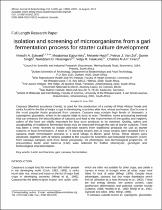 ResearchSpace
ResearchSpace
Isolation and screening of microorganisms from a gari fermentation process for starter culture development
JavaScript is disabled for your browser. Some features of this site may not work without it.
- ResearchSpace
- →
- Research Publications/Outputs
- →
- Journal Articles
- →
- View Item
| dc.contributor.author |
Edward, VA

|
|
| dc.contributor.author |
Egounlety, M

|
|
| dc.contributor.author |
Huch, M

|
|
| dc.contributor.author |
Van Zyl, PJ

|
|
| dc.contributor.author |
Singh, S

|
|
| dc.contributor.author |
Nesengani, ND

|
|
| dc.contributor.author |
Haakuria, VM

|
|
| dc.contributor.author |
Franz, CMAP

|
|
| dc.date.accessioned | 2012-10-24T07:24:20Z | |
| dc.date.available | 2012-10-24T07:24:20Z | |
| dc.date.issued | 2012-08 | |
| dc.identifier.citation | Edward, VA, Egounlety, M, Huch, M, Van Zyl, PJ, Singh, S, Nesengani, ND, Haakuria, VM and Franz, CMAP. 2012. Isolation and screening of microorganisms from a gari fermentation process for starter culture development. African Journal of Biotechnology, vol. 11(65), pp. 12865-12877 | en_US |
| dc.identifier.issn | 1684–5315 | |
| dc.identifier.uri | http://www.academicjournals.org/Ajb/PDF/pdf2012/14Aug/Edward%20et%20al.pdf | |
| dc.identifier.uri | http://hdl.handle.net/10204/6212 | |
| dc.description | Copyright: 2012 Academic Journals | en_US |
| dc.description.abstract | Cassava (Manihot esculenta Crantz), is used for the production of a variety of West African foods and ranks fourth in the list of major crops in developing countries after rice, wheat and maize. Gari is one of the most popular foods produced from cassava. Cassava may contain high levels of linamarin, a cyanogenic glucoside, which in its natural state is toxic to man. Therefore, some processing methods that can enhance the detoxification of cassava and lead to the improvement of the quality and hygienic safety of the food are vitally important for less toxic products to be obtained. Quality, safety and acceptability of traditional fermented foods may be improved through the use of starter cultures. There has been a trend recently to isolate wild-type strains from traditional products for use as starter cultures in food fermentation. A total of 74 bacterial strains and 21 yeast strains were isolated from a cassava mash fermentation process in a rural village in Benin, West Africa. These strains were assessed, together with 26 strains isolated at the Council for Scientific and Industrial Research (CSIR) from cassava samples sent from Benin previously, for phenotypic and technological properties. 24 presumptive lactic acid bacteria (LAB) were selected for further phenotypic, genotypic and technological characterization. | en_US |
| dc.language.iso | en | en_US |
| dc.publisher | Academic Journals | en_US |
| dc.relation.ispartofseries | Workflow;9452 | |
| dc.subject | Lactic acid bacteria | en_US |
| dc.subject | LAB | en_US |
| dc.subject | Cassava | en_US |
| dc.subject | Gari | en_US |
| dc.subject | Fermentation | en_US |
| dc.subject | West African foods | en_US |
| dc.title | Isolation and screening of microorganisms from a gari fermentation process for starter culture development | en_US |
| dc.type | Article | en_US |
| dc.identifier.apacitation | Edward, V., Egounlety, M., Huch, M., Van Zyl, P., Singh, S., Nesengani, N., ... Franz, C. (2012). Isolation and screening of microorganisms from a gari fermentation process for starter culture development. http://hdl.handle.net/10204/6212 | en_ZA |
| dc.identifier.chicagocitation | Edward, VA, M Egounlety, M Huch, PJ Van Zyl, S Singh, ND Nesengani, VM Haakuria, and CMAP Franz "Isolation and screening of microorganisms from a gari fermentation process for starter culture development." (2012) http://hdl.handle.net/10204/6212 | en_ZA |
| dc.identifier.vancouvercitation | Edward V, Egounlety M, Huch M, Van Zyl P, Singh S, Nesengani N, et al. Isolation and screening of microorganisms from a gari fermentation process for starter culture development. 2012; http://hdl.handle.net/10204/6212. | en_ZA |
| dc.identifier.ris | TY - Article AU - Edward, VA AU - Egounlety, M AU - Huch, M AU - Van Zyl, PJ AU - Singh, S AU - Nesengani, ND AU - Haakuria, VM AU - Franz, CMAP AB - Cassava (Manihot esculenta Crantz), is used for the production of a variety of West African foods and ranks fourth in the list of major crops in developing countries after rice, wheat and maize. Gari is one of the most popular foods produced from cassava. Cassava may contain high levels of linamarin, a cyanogenic glucoside, which in its natural state is toxic to man. Therefore, some processing methods that can enhance the detoxification of cassava and lead to the improvement of the quality and hygienic safety of the food are vitally important for less toxic products to be obtained. Quality, safety and acceptability of traditional fermented foods may be improved through the use of starter cultures. There has been a trend recently to isolate wild-type strains from traditional products for use as starter cultures in food fermentation. A total of 74 bacterial strains and 21 yeast strains were isolated from a cassava mash fermentation process in a rural village in Benin, West Africa. These strains were assessed, together with 26 strains isolated at the Council for Scientific and Industrial Research (CSIR) from cassava samples sent from Benin previously, for phenotypic and technological properties. 24 presumptive lactic acid bacteria (LAB) were selected for further phenotypic, genotypic and technological characterization. DA - 2012-08 DB - ResearchSpace DP - CSIR KW - Lactic acid bacteria KW - LAB KW - Cassava KW - Gari KW - Fermentation KW - West African foods LK - https://researchspace.csir.co.za PY - 2012 SM - 1684–5315 T1 - Isolation and screening of microorganisms from a gari fermentation process for starter culture development TI - Isolation and screening of microorganisms from a gari fermentation process for starter culture development UR - http://hdl.handle.net/10204/6212 ER - | en_ZA |





